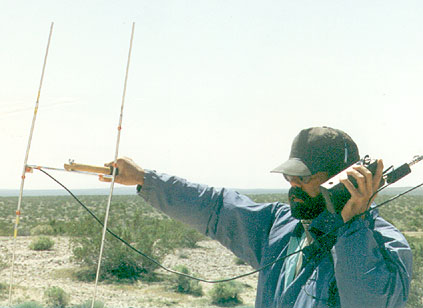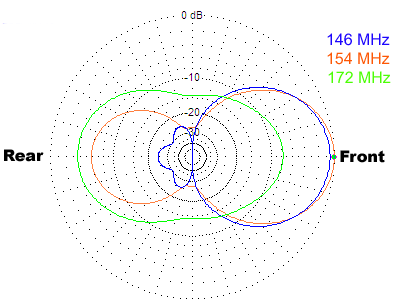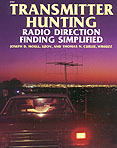 Q: What should I do if I hear a radio tag signal?
Q: What should I do if I hear a radio tag signal?
 Q: What should I do if I hear a radio tag signal?
Q: What should I do if I hear a radio tag signal?
A: First, make sure you're really hearing a wildlife tag. Read the Was That Really A Wildlife Tag? page at this site for help in verifying key signal characteristics.
Note the date, time, exact frequency, your location (with GPS coordinates if possible), and any unusual signal characteristics. Make tape recordings and/or digital audio files if you can, for analysis and verification.
If possible, go mobile and try to find the area where signal is strongest. Notify Joe Moell (k0ov@homingin.com) and the researcher (if stated) via e-mail, including full details of the signal. If you are a member of the Biotrackers mailing list, post the information there also.
If you have a directional antenna and want to attempt to pinpoint the animal's exact location, great. But keep in mind that most critters are tagged because they are at risk as a species. They must be treated with respect if they are to survive. Observe them from a distance with binoculars or a spotting scope. Do not disturb them or their homes. Also be aware that other researchers may be using 172 and 150 MHz tags. You might be tracking something much larger and more dangerous than a bird or bat!
If you get close enough to a bird to identify it as the one that's radio-tagged, look for leg bands. Individual birds can be identified by noting the color of the bands and their sequence, as well as which leg they are on. Contact the birding enthusiasts in your area and your local Audubon Society for more information on observation techniques and birdwatching etiquette.
Q: Why do you need so many frequencies?
A: So that the critters can be identified and tracked individually. Biologists assign a separate frequency to each animal, when possible, because it eliminates the need to put special coding on the signals. That would add cost to receivers and transmitters and would reduce battery life. Researchers use special narrowband receivers such as the LA12-Q by AVM Instrument Company, Limited. Its frequency readout (1 KHz resolution) shows exactly which tag is being received.
Communications Specialists, a well-known maker of subaudible tone encoders/decoders, sells the $695 R-1000 hand-held "telemetry receiver" (not to be confused with the Kenwood shortwave receiver with the same model number). It is specifically designed for monitoring and tracking of narrowband signals such as bio-tags. It tunes in 0.1 to 1.0 KHz steps, has IF bandwidth of just 1.2 KHz (at -6 dB) and a product detector for CW reception. It covers any 4 MHz segment of the 148 to 174 MHz band, as specified when ordering.
Q: Why not use frequencies spaced 5 KHz apart, the way most scanners tune?
A: Professional biologists do not normally utilize consumer receivers with 5 KHz channel spacing. They prefer narrower bandwidth receivers with product detectors, which provide greater sensitivity (and thus greater tracking range) than the popular scanners. This also gives them more usable frequencies in a given radio band.
Q: I don't have a professional tracking receiver. What can I use?
A: A sensitive multimode (FM/AM/CW/SSB) receiver in the CW or SSB mode provides performance nearly equal to a professional bio-receiver. Check catalogs from outlets such as Grove Enterprises. Current models that are ideal for indoor monitoring posts include the AOR AR5000 and Icom R-8500. These sets can also be operated from +12 VDC for use in a vehicle. Older models that are equally suitable but perhaps more economical include the AOR AR3000A and Icom R7100-2.
Some HF shortwave receivers such as the Drake R8-A and R8-B include provisions for a VHF converter to provide multimode coverage of 108-174 MHz. The Drake ACC-43 converter appears to be usable with other receivers besides the R8 series. Has anyone tried it?
 Experienced experimenters may wish to build their own receiving converters for use with a multimode receiver or transceiver on the ten-meter band for a base station. A basic design by Rod Kreuter WA3ENK is here, adapted from Rod's article in QST Magazine, January 1997 issue. Changing the preamp tuned circuits and local oscillator frequency should put it on 172 or 150 MHz. Another idea: Make similar modifications to a 2m-to-10m converter such as the Model CC146-28 by Hamtronics, Incorporated.
Experienced experimenters may wish to build their own receiving converters for use with a multimode receiver or transceiver on the ten-meter band for a base station. A basic design by Rod Kreuter WA3ENK is here, adapted from Rod's article in QST Magazine, January 1997 issue. Changing the preamp tuned circuits and local oscillator frequency should put it on 172 or 150 MHz. Another idea: Make similar modifications to a 2m-to-10m converter such as the Model CC146-28 by Hamtronics, Incorporated.
Hand-held multimode receivers such as the Alinco DJ-X10T, AOR AR-8000, AR8200, Icom IC-R10 and Yaesu VR-500 are well suited for field use. (I use the R10.) Also look on the Web for new and used bargains in discontinued models such as the Trident TR2400 and Sony ICF-PRO80 (shown in the hand of the tortoise researcher at right).
The new radio add-ons for personal computers appear to be ideal for wildlife monitoring from a base station. Check into the WinRadio WR-1000 or Icom PCR1000 computer receivers. For less than the cost of a multimode hand-held receiver (plus the cost of your PC, of course), you get wide-frequency multimode coverage, computerized scan and search functions, plus extras such as a spectrum display.
For maximum range when monitoring from your home, use an outdoor antenna with wide frequency coverage, plus low-loss coaxial cable. The Diamond Antenna model D130J discone is a popular choice.
Q: Are any Amateur Radio transceivers suitable?
A: A few Amateur Radio VHF transceivers and satellite base stations have receivers with CW/SSB capability that cover 148 to 174 MHz. Examples of such sets currently in the stores include the Icom IC-821H and IC-910H, and Yaesu FT-100 and FT-847. Some older VHF/UHF multimode sets may also have extended receive frequency range. Caution: Manufacturers' specifications for receiver sensitivity and cross-modulation performance usually are guaranteed only within the Amateur Radio bands. Some owners of extended range FM-only transceivers have discovered that their receivers are "numb" on many frequencies outside the ham bands. I welcome your reports of measured receiver sensitivity on 172 MHz from owners/users of multimode extended-range sets, both current and older models.
Q: My two-meter hand-held tunes up to 174 MHz, and so does my scanner. They only work in the FM and AM modes, though. Can I use them?
A: AM and FM modes are not optimum because they do not provide the "chirp" sound that is characteristic of the tags on a CW/SSB receiver. Here are sound samples of a tag-like transmitter being received in the AM mode and the FM mode. A positive identification cannot be made in these modes, but the characteristic periodic quieting of the noise is a good clue that the signal may be worth investigating. The receiver's S-meter will also bounce up periodically, which makes direction-finding with a beam antenna practical. So give it a try. You may find that your extended range hand-held does not have good sensitivity on non-ham tag frequencies, as discussed above. Your scanner may work well on tag frequencies, or it may be plagued by "birdies" and images from nearby strong VHF base stations and mobiles. Expect best results in rural areas, away from communications and broadcast transmission sites.
Tag frequencies are grouped very closely, which may be a problem with typical 5 KHz channel spacing of FM scanners and ham sets. The passband of your set may include more than one tag frequency. That doesn't mean you can't copy the tag, it just means that it will be difficult to identify exactly which tag is being heard.
To increase system sensitivity and make it easier to identify the tags, consider adding an outboard single sideband (SSB) detector to your FM scanner or monitor receiver. The circuit consists of a beat frequency oscillator (BFO), product detector, and audio amplifier. Detailed construction information is in Chapter 11 of the book TRANSMITTER HUNTING---Radio Direction Finding Simplified by Moell and Curlee.
Q: So all I have to do is program the frequencies into my scanner, set it to scan, and wait for something to happen, right?
A: Unfortunately, it isn't that simple. Tag transmitters send very short "dits" to conserve battery life. They are on the air for only about 20 milliseconds (1/50 of a second) at a time, and the dits are over a second apart.
In the "scan" or "search" mode with the squelch closed, a typical scanner steps through dozens of frequencies every second, staying on each frequency for only a few milliseconds. Even if a tagged critter is in close proximity to you, the probability of your scanner landing on its exact tag frequency at the exact millisecond that a transmitted "dit" occurs is very remote. If the receiver hit the tag frequency at the exact instant of a transmission, the dit might not be long enough to open the squelch. And even if it did open the squelch, the only result would be that the receiver would stop scanning for a couple of seconds, then resume. You probably wouldn't even realize what happened, especially if the receiver was unattended.
So you can't just program the tag frequencies into your scanner and walk away. You must find a way for the receiver to stay on each frequency at least two seconds (long enough for a dit to occur) and then listen (with the squelch open) on each frequency for dits. Your scanner might have a "scan delay" feature that forces it to resume frequency stepping after a certain period of time on a busy channel. With that feature in use and the squelch open, the receiver will step frequencies at the scan delay rate, which may be ten seconds or more. On some scanners, this delay is adjustable. Check your owner's manual and set it to approximately 5 seconds for open-squelch stepping.
Without scan delay, the only way to be sure you won't miss the tag transmissions with an ordinary NBFM scanner is to open the squelch and manually step through the frequencies, remaining on each one long enough to be sure that no dits are present. Or if you have a multi-mode scanner/receiver such as the IC-R10, set the mode for CW, USB or LSB, open the squelch, and slowly tune the frequency range with the Tuning Step set for 1 KHz. This slow tuning/stepping/listening requires time and patience, but that's what it takes. Even if you only have time to step through the frequencies a couple of times a day, it's far better than just scanning with the squelch closed.
Q: Can I use my two-meter RDF "sniffing" beam to track the tag transmitters?
 A: Do not expect a yagi or cubical quad for the 146 MHz ham band to give useful directional indications on 172 MHz bio-tags. Such beams are optimized for frequency range of only a few MHz. For example, see the illustration at right, which shows the azimuthal directivity pattern of a 3-element 2-meter "measuring tape" yagi as analyzed by EZNEC. Physical dimensions of this yagi are also typical of lightweight hand-held antennas such as the Arrow II series by Arrow Antennas. The oustide ring represents 8 dB gain relative to an isotropic antenna.
A: Do not expect a yagi or cubical quad for the 146 MHz ham band to give useful directional indications on 172 MHz bio-tags. Such beams are optimized for frequency range of only a few MHz. For example, see the illustration at right, which shows the azimuthal directivity pattern of a 3-element 2-meter "measuring tape" yagi as analyzed by EZNEC. Physical dimensions of this yagi are also typical of lightweight hand-held antennas such as the Arrow II series by Arrow Antennas. The oustide ring represents 8 dB gain relative to an isotropic antenna.
The blue plot is the two-meter yagi's performance at 146 MHz. Gain in the forward direction is nearly 8 dB, providing very good sensitivity. The 3 dB beamwidth is +/- 30 degrees, so bearings will be sharp. The three rear lobes are down 25 dB (four S-units) or more, which is excellent.
The orange plot is for this same antenna at 154 MHz. The forward lobe is the same, but the rear lobe is only 6 dB (one S-unit) below the forward lobe. In a typical outdoor environment, it may be very difficult to tell whether the tag is ahead or behind with this pattern.
The green plot is for this antenna at 172 MHz, where it is useless for RDF. The rear lobe is 3 dB stronger than the front lobe. The feedpoint matching of this antenna is poor, resulting in feedline signal pickup that fills in all the pattern nulls, making them only 7 dB less than the forward gain.
So for effective direction finding, you will need a beam antenna that is designed for optimum response in the tag frequency range. You could "cut down" a 2-meter beam or you can build one from scratch. Here are some suggested dimensions (in inches) for 3-element 172.5 MHz and 151 MHz yagis using quarter-inch diameter aluminum arrow shafts (very light!) mounted on a 3/4-inch square aluminum boom.
End-to-end element lengths (including boom width):
172.5 151 MHz
Director 29.6 33.8
Driven Element 33.15 37.85
Reflector 34.9 39.85
Spacing (to Driven Element):
Director 12.70 14.5
Reflector 13.8 15.75
There are many Amateur Radio publications with information on physical construction of yagi antennas, such as The ARRL Handbook.
Four-element cubical quads like the ones in Chapter 4 of TRANSMITTER HUNTING---Radio Direction Finding Simplified are well suited for tracking in your vehicle. Just as with yagis, your quad must be optimized for the tag frequency band. To adapt a two-meter quad design for 172 MHz tag tracking, multiply the element circumferences and spacings by 0.846, which is the ratio of the frequencies (146 divided by 172.5). For 151 MHz, multiply by 0.967.
![]() Join the Bio-Trackers Mailing List
Join the Bio-Trackers Mailing List
Listen to an Actual Tag Signal
![]() Click here to play or download a MP3 file of a typical radio tag signal, courtesy of biologist Helen Trefry of Environment Canada. This is how an wildlife tag sounds on a professional researcher's receiver, which is narrowband and has a beat frequency oscillator (BFO) and product detector (CW or SSB mode) to create a "chirp" sound from the slight frequency shift of the transmitter. This is NOT how it will sound on a typical scanner or wideband ham transceiver in the AM or FM mode (see FAQ above).
Click here to play or download a MP3 file of a typical radio tag signal, courtesy of biologist Helen Trefry of Environment Canada. This is how an wildlife tag sounds on a professional researcher's receiver, which is narrowband and has a beat frequency oscillator (BFO) and product detector (CW or SSB mode) to create a "chirp" sound from the slight frequency shift of the transmitter. This is NOT how it will sound on a typical scanner or wideband ham transceiver in the AM or FM mode (see FAQ above).
Copyright © 2003-2008 Joseph D. Moell. All rights reserved. Photos of the researcher with RDF gear are by Joe Moell KØOV from Homing In in 73 Magazine for July 1995.
 Go to the Was That Really A Wildlife Tag? page at this site
Go to the Was That Really A Wildlife Tag? page at this site
Back to the New Wildlife Tracking Projects page of this site
Back to the Burrowing Owl Project History page of this site
Back to the Homing In Radio Direction Finding home page
 This page updated 22 October 2008
This page updated 22 October 2008